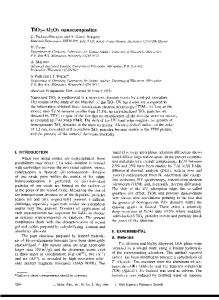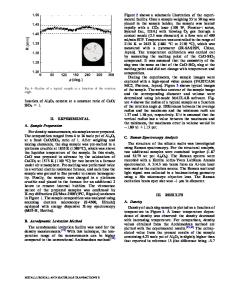The Dissolution Kinetics of Al 2 O 3 into Molten CaO-Al 2 O 3 -Fe 2 O 3 Slag
- PDF / 2,864,231 Bytes
- 12 Pages / 593.972 x 792 pts Page_size
- 89 Downloads / 454 Views
RODUCTION
IRON ore sinter is the main raw material for ironmaking using blast furnaces in the East Asian regions, especially China, Japan, and Korea. Good-quality iron ore sinters are critical for strengthening the smelting operation of blast furnaces.[1,2] As the main bonding phase of high-basicity sinter, the physical and chemical properties of calcium ferrite melt and the texture of the structure after solidification have great influences on the quality of the resultant product. As ore quality decreases, iron ores with higher gangue compositions are used in sintering, which results in chemical composition fluctuations in the raw material. Iron ores from Australia, India, and Brazil were recently observed to contain high Al2O3 contents.[2] Previous studies show that high Al2O3 contents have negative effects on the properties of the sinter and its sintering index because Al2O3 contents are directly related to silicon-ferrite of calcium and aluminum (SFCA) generation.[3–9] Several studies have focused on the influence of Al2O3 on the formation of SFCAs during sintering. Maeda et al. investigated the effects of Al2O3 on the generation rate of calcium ferrite melts; results showed that Al2O3 affects the calcium ferrite by increasing its fusion rate and decreasing its formation temperature. Al2O3 also promotes dissolution of solid Fe2O3 in the calcium ferrite melt.[10] Iron ore sintering involves a solid–liquid coexistence reaction, and the heating times employed in this process at high temperature are usually very short. The solid– liquid reaction rate is critical for the formation of the final components of SFCAs. Thus, exploring the reaction mechanism and factors influencing iron ore sintering is an SHENGLIN XIANG, BIN YU, and JIAQING YIN, Master Students, and XUEWEI LV and JIAN XU, Assistant Professors, are with the School of Materials Science and Engineering, Chongqing University, Chongqing, China. Contact e-mail: [email protected] Manuscript submitted December 17, 2013. Article published online August 20, 2014. 2106—VOLUME 45B, DECEMBER 2014
important endeavor. Several studies have focused on characterizing the formation ability of the liquid phase by analyzing the relationship between the chemical composition and amount of the liquid phase available. However, few studies on the kinetics of solid–liquid reaction processes, specifically the dissolution kinetics of Al2O3 into the calcium ferrite melt, are available. The present study will promote the current understanding on the formation kinetics of SFCA from calcium ferrite. A large amount of literature[11–23] on the dissolution of Al2O3 in other melts is available. The methods used to investigate dissolution kinetics in these studies include in situ and ex situ investigation. However, the in situ investigation is not suited to study the dissolution kinetics of Al2O3 into molten CaO-Al2O3-Fe2O3 slag. Because the shrink of Al2O3 particle or ball cannot be real-time observed during the dissolving process of Al2O3 into molten CaO-Al2O3-Fe2O3 slag by hightemperature confocal l
Data Loading...











